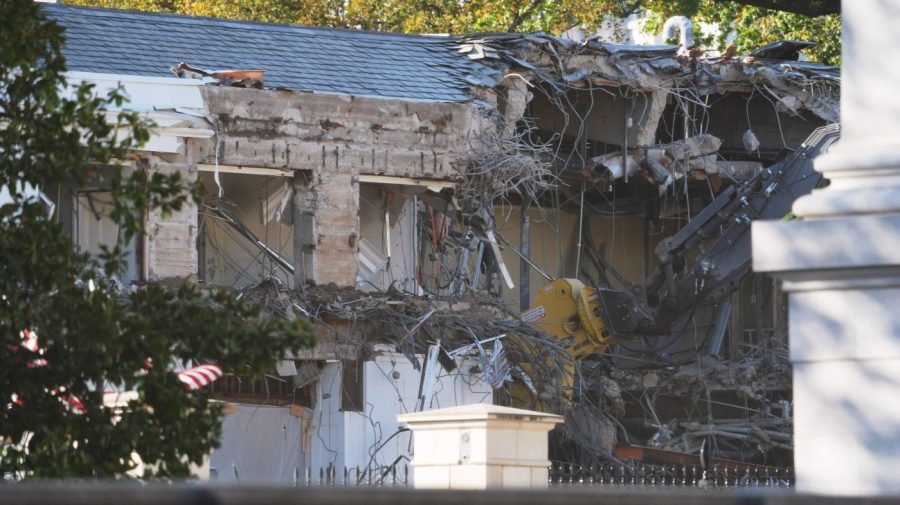Trump’s vainglorious White House ballroom will be a monument to failure

As I watched a gray Volvo excavator tear down part of the historic White House East Wing on Monday afternoon, I thought about how perfectly that act of needless, wasteful, self-aggrandizing destruction summed up President Trump’s first 10 months in office.
The East Wing has to go in order to make room for a sprawling, $250 million ballroom project privately financed by some of the nation’s richest Trump supporters. It was a project nobody except Trump ever wanted, an ego salve for a presidency destined to go down in history as both deeply shameful and devoid of any meaningful policy achievements. At least he’ll get to look at some big trucks as his administration smashes against the rocks.
The partially collapsed East Wing is a visible representation of a government and an economy that Trump has led into partial collapse at near-record speed. Federal agencies have been shuttered now for three weeks. Millions of Americans now struggle to find work while facing ever-higher prices at the grocery store and skyrocketing health insurance premiums. Trump may be building his personal 90,000-square-foot Neronian pleasure palace, but few Americans are in the mood to throw parties of their own.
There was something deeply unsettling about watching Trump’s tractors bring down the rafters of an East Wing first commissioned by Theodore Roosevelt in 1902. Roosevelt embarked on the big renovation because the building — then just called the President’s House — hadn’t seen a good carpenter since its reconstruction after the British arson of 1814. Unlike with Trump’s self-referential dream of tagging his name to a giant add-on, Roosevelt sought to repair the aging structure into a building that reflected America’s emergence as a great 20th century power. The two men’s visions for our national future couldn’t be more different.
Roosevelt’s renovation was an exercise in showcasing the modesty of a democracy that didn’t need to coat itself in stick-on gold appliques in order to feel important. It was also intended, in Roosevelt’s own words, to do justice and honor to the civic spirit of the American people. Trump would know nothing of that — his ballroom is bankrolled exclusively by the plutocratic rich, by his country club buddies, by men with billions of dollars in pending business before the government regulators Trump now controls like partisan puppets.
His ballroom isn’t a testament to American greatness. It is the nation’s most garish kickback machine.
No, I don’t believe in freezing the White House in amber. The building’s dynamism is one of its most beautiful qualities. Over the years, the grounds have seen rose gardens installed and ripped out. It once played host to William Howard Taft’s pet cow. But Trump’s project speaks to the darker impulses of near-imperial power in the form of a building so large it will blot out the Executive Mansion entirely.
That such an imposing monument to private, partisan wealth will dominate the People’s House is as much a warning about the failing health of our democracy as it is a glaring eyesore of Speerist design philosophy. That ballroom may only be the first of Trump’s lesions on Washington’s landscape, too, because our builder-in-chief is also planning a massive triumphal arch that would rival the Lincoln Memorial in size and scope.
Amid a government shutdown, massive increases in the cost of health care and legally questionable deployments of federal troops into half a dozen American cities, what great American triumph could the Arc de Trump possibly be celebrating? Does a presidency under which millions of Americans can’t even feed their own children really deserve all that gold and marble?
When Trump is done grafting his corrosive ideology onto the White House, the American people will be left with a building that looks more like the imperial palace of Augustus than it does the home of a representative of the people. That may make Trump feel mighty, but it won’t make his administration any less disastrous for the people who mistakenly put their trust in him to defend their most fundamental interests.
Trump hopes the golden gleam of his monumental architecture can blind the American people to the suffering he has brought upon them after less than a year in office. But a failure wrapped in cheap gold leaf is still a failure, even if it shines. In the end, Trump will be remembered not for the empty facades he constructed, but for the hundreds of millions of Americans he failed.
Max Burns is a veteran Democratic strategist and founder of Third Degree Strategies.